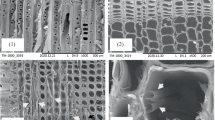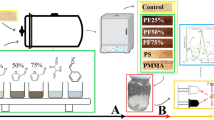Summary
X-ray microdensitometric analysis was employed for the detection of fungi attack in wood of pine and beech in comparison with the studies of specimen weight loss tests. Two species of fungi were used:Gloeophyllum trabeum (Pers.:Fr. Murrill) andTrametes versicolor (L.:Fr. Pilat). We select these species to induce typical decay attack mainly on cellulose in pine (brown rot) and mainly on lignin in beech (white rot). The attack was conducted for 1, 2, 3, 4 and 5 months in sterile laboratory conditions. After 5 months all the values of density components decreased. In beech the loss was of about 25% for all components. In pine the decreasing of the earlywood density component was of about 10% and in latewood of about 22%. The corresponding mass density losses, determined by gravimetric method, were approximately 18% for beech and 16% for pine.
Similar content being viewed by others
References
Bucur, V. 1985: Ultrasonic, hardness and X-ray densitometric analysis of wood. Ultrasonics, 23(6): 269–275
Bucur, V.; Navarrete, A.; de Troya, M. T.; Sanchez, E.; Garros, S.; Diez, R. 1993: Fungi decay in wood by combined nondestructive testing. Ultrasonics International 93 Conference Proceedings, Vienna, Austria, 6–8 July 1993, p 287–290
Bucur, V.;Herbe, C.;Nosei, G. 1994: Annual ring characteristics of Pinus taeda measured by ultrasonic and X-ray techniques. Iawa J. 15(2): 121–132
Kaiserlik, J. H. 1978: Nondestructive testing methods to predict effect of degradation on wood: a critical assessment. Gen. Tech. Rept. F.P.L. 19, USDA Forest Service, Forest Products Laboratory, Madison, U.S.A
Keller, R. 1968: Des caractéristiques nouvelles pour l'étude des propriétés mécaniques des bois: les composantes de la densité. Ann. Sci. Forest. 25(4): 237–249
Mothe, F. 1992: Programme CERD pour analyse densitométrique des cernes annuels. INRA, Centre de Nancy - document a distribution limité
Polge, H. 1963: Une nouvelle méthode de détermination de la texture du bois: l'analyse densitométrique de clichés radiographiques. Ann. Sci. Forest. 20(4): 531–581
Polge, H. 1978: Fifteen years of wood radiation densitometry. Wood Sci. Techn. 12: 187–196.
Polge, H., Keller, R., Thiercelin, F. 1973: Influence de l'élagage de branches vivantes sur la structure des accroissements annuels et sur quelques caractéristiques du bois de Douglas et de Grandis. Ann. Sci. Forest. 30(2): 127–140
Schweingruber, F.H. 1988: Tree rings. Basics and applications of dendrochronology. Kluwer Academic Publishers. Dordrecht
Troya, M.T. de; Navarrete, A.; Sanchez, A.; Bucur, V. 1993: Kinetics of the wood degradation produced by wood decay fungi. International Resh. Group on Wood Preservation, IRG/WP 93 - 200916, 11 p:
Author information
Authors and Affiliations
Additional information
The authors wish to thank ”la Région Rhône - Alpes, Lyon, France” for the financial support of this research
Rights and permissions
About this article
Cite this article
Bucur, V., Garros, S., Navarrete, A. et al. Kinetics of wood degradation by fungi with x-ray microdensitometric technique. Wood Sci.Technol. 31, 383–389 (1997). https://doi.org/10.1007/BF01159156
Received:
Issue Date:
DOI: https://doi.org/10.1007/BF01159156




